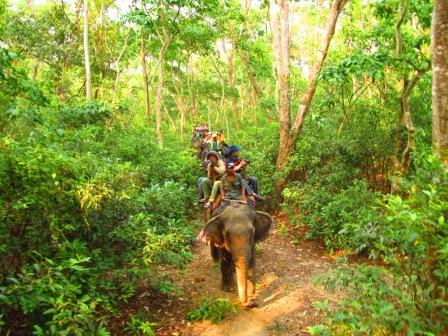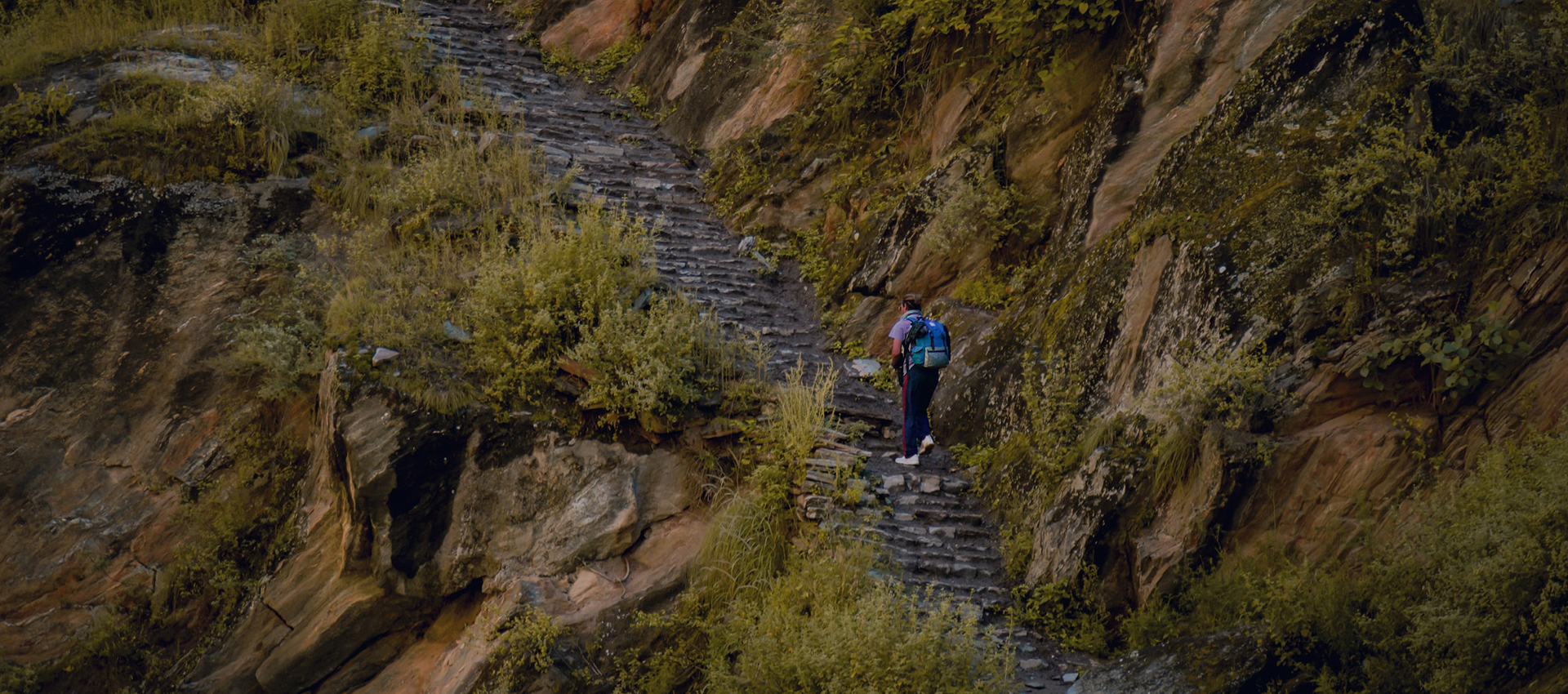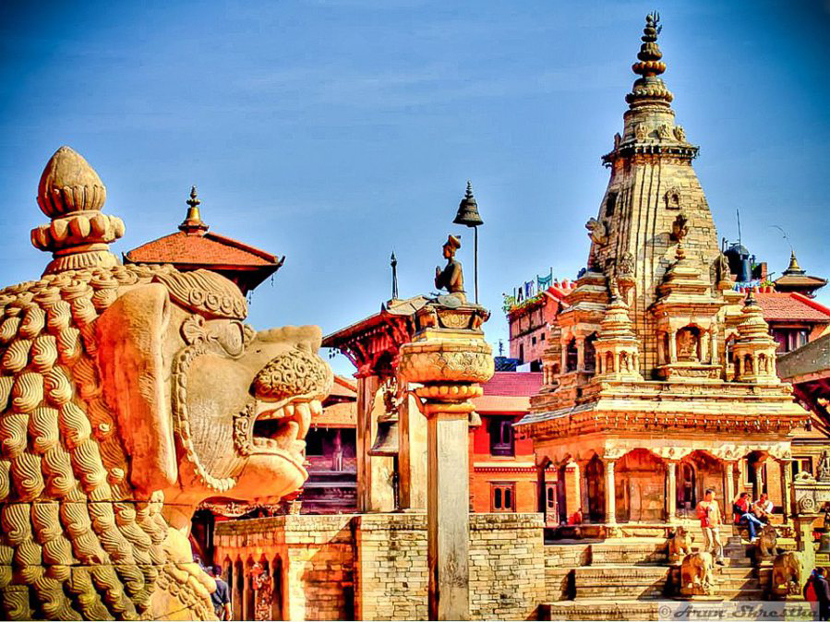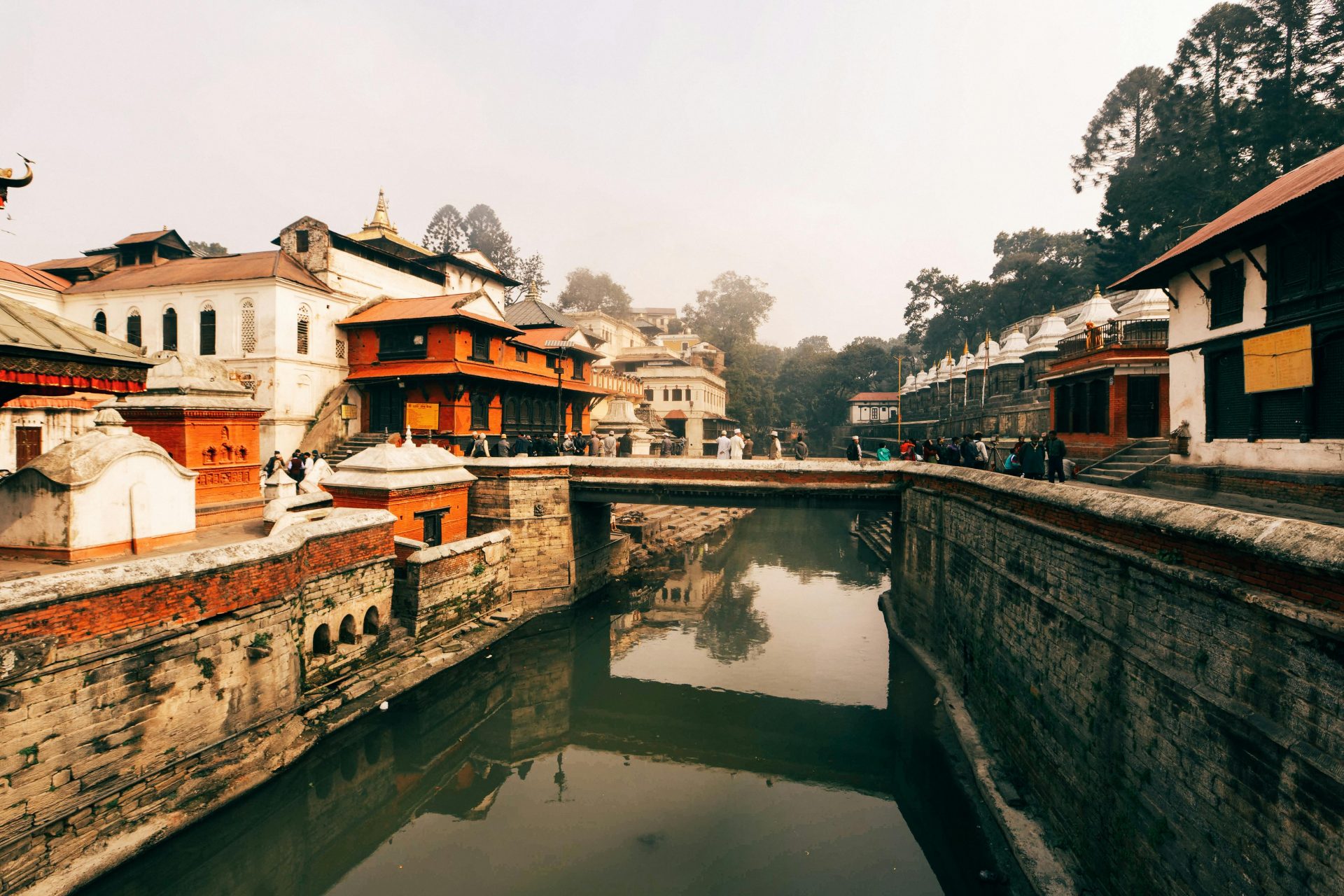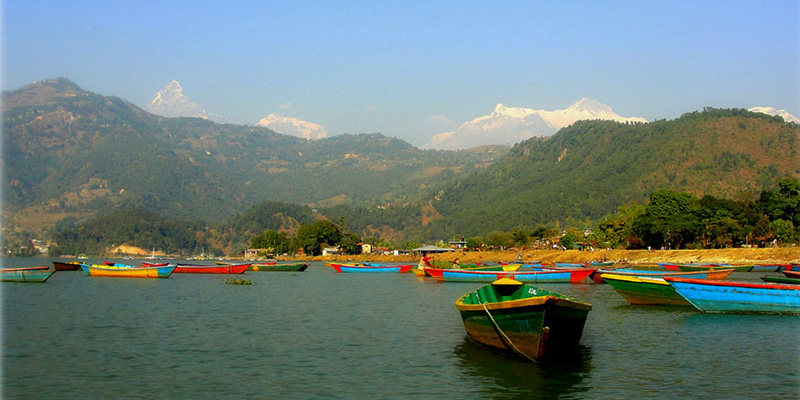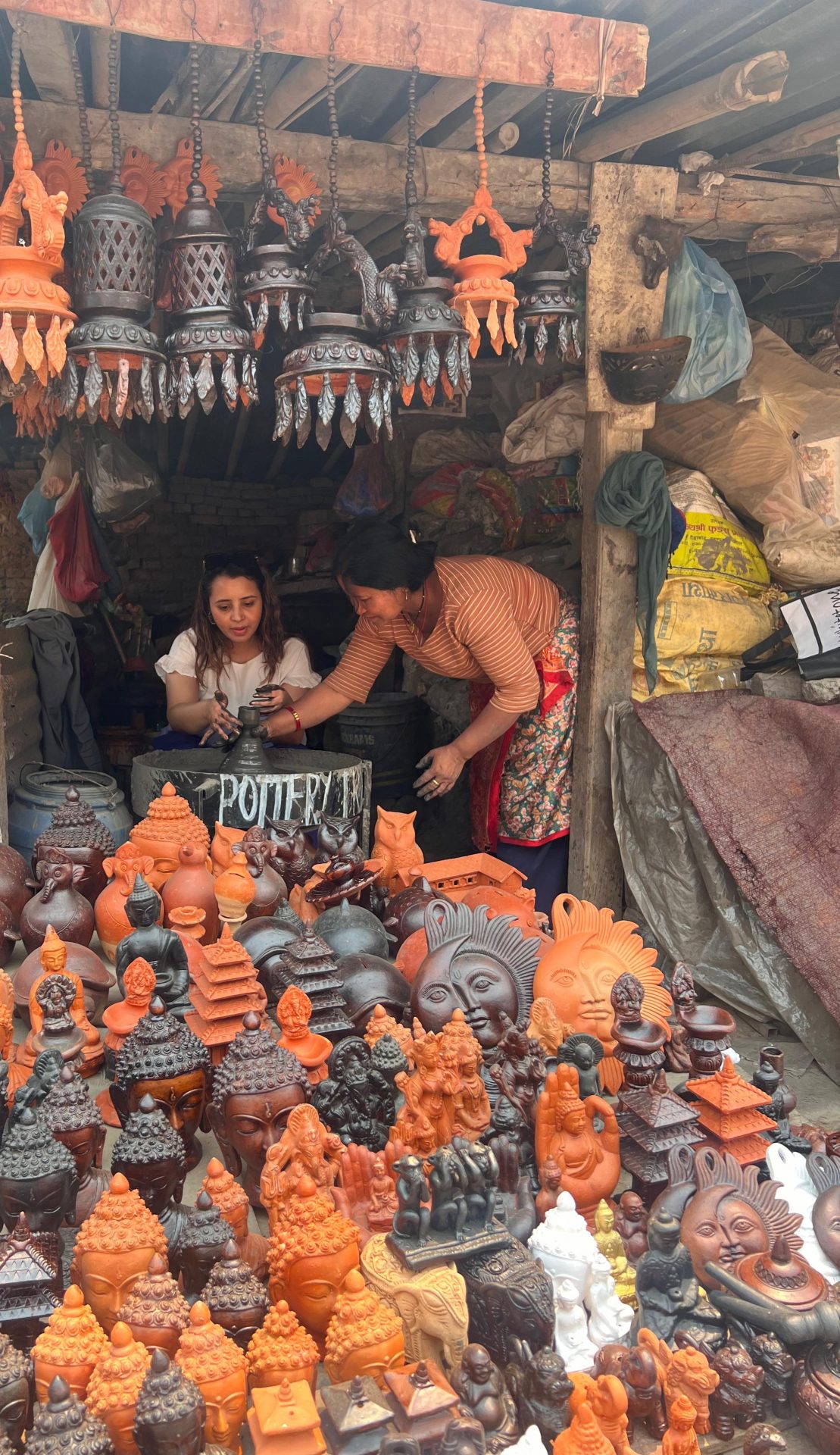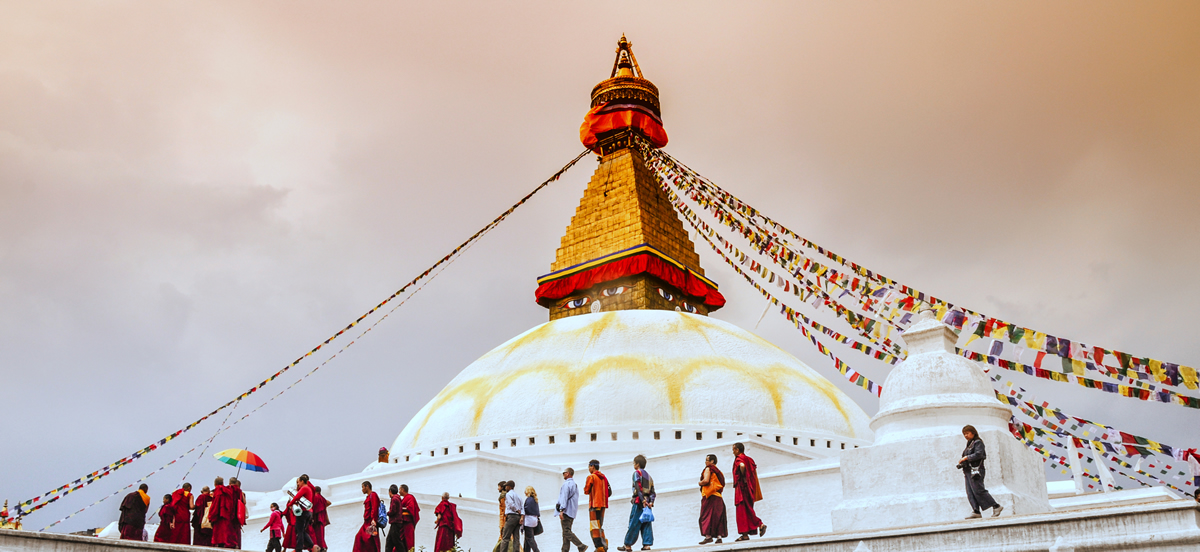
Nepal Highlight Tour along with Short Hiking – 19 Days
-

Duration
19 Days
-

Country
Nepal
-

Trip Type
Safari Tours
-

trip starts from
Kathmandu
-

trip ends in
Kathmandu
-

Max altitude
2175m
-

Accommodation
Lodge, Hotel
-

Transportation
Car, Bus, Plane
-

Group size
Min. 2 pax
Overview
Table of Contents
ToggleNepal Highlight Tour
Nepal Highlight tour offers a blend of short hikes along with cultural and traditional exploration. It is a perfect blend with short hikes around nature, and hence makes this trip strikingly magnificent.
It gives a chance to experience major highlights of Nepal along with short excursions to nearby villages, farmlands, and hills. This trip includes the major cities of Nepal. Excursions like these are a way to learn and explore nature.
Nepal Highlight Tour Itinerary
We visit Sarangkot one of the popular tourist place in pokhara early in the morning for sunrise views. Then we visit popular attractions like Devi’s fall (waterfall), Fewa Lake, Barahi Temple, World Peace Pagoda, and others. During our stay in Pokhara, we also experience a half day Mountain biking tour.
Leaving Pokhara city behind, we then move towards Chitwan via Gorkha bazaar and Gorkha palace. Visiting these places takes us centuries back to the era of Prithvi Narayan Shah.
Finally, after arriving at Chitwan we go for jungle safari, cultural shows. There we immerse ourselves in plenty of wilderness activities with the chance to spot numerous endangered species of floras and faunas.
Before ending our amazing Nepal Highlight Tour with Short Hiking, we drive back to Kathmandu. The next morning, if you want to see the world’s highest peaks in front of your eyes, then you can join an hour-long mountain flight.
Hence in this way during our final couple of days of this trip, we visit other few naturally beautiful and culturally rich villages, hillsides and world heritage sites. And with all of these wonderful memories, lots of things to cherish, we conclude our Nepal highlights with short hiking tour.
Best Time to Travel
Autumn (Sept–Nov) – clear skies, best views
Spring (Mar–May) – blooming rhododendrons & mild weather
Tours are available year-round with slight itinerary adjustments in monsoon and winter
Let Nepal Captivate You
From golden temples and ancient cities to wild jungles and snow-capped mountains, the Nepal Highlight Tour reveals the soul of Nepal in one carefully curated journey. Whether you’re seeking adventure, peace, or cultural immersion, Nepal will surprise and inspire at every turn.
Join short and easy Nepal Highlights Tour with short hiking with Euro-Asia treks for sightseeing around the three major cities nearby Kathmandu ideal for those who want to experience Nepali culture and natural splendor in short period of time. You can always join other treks or tours after completion of this trip and create the best holiday memories in Nepal.
facts
-

Duration
19 Days
-

Country
Nepal
-

Trip Type
Safari Tours
-

trip starts from
Kathmandu
-

trip ends in
Kathmandu
-

Max altitude
2175m
-

Accommodation
Lodge, Hotel
-

Transportation
Car, Bus, Plane
-

Group size
Min. 2 pax
highlights
- Guided City Tour in Kathmandu Valley and Pokhara.
- Cooking Classes and Yoga Classes.
- Hiking to Nagarkot and Peace Stupa.
- Country side drives Kathmandu, Pokhara, Chitwan and Kathmandu.
- Boat Ride in Fewa Lake.
- Jungle Activities in Chitwan National Park.
- Excursion to Saranagkot.
- Mountain Biking Tour.
Itinerary Overview
- Day 01: Arrival in Kathmandu
- Day 02: Yoga and Full day sightseeing in Kathmandu city(Swoyambhunath, Kathmandu Durbar Square, Patan Durbar Square, Tibetan Refugee Camp)
- Day 03: Yoga and Full day Sightseeing in Bhaktapur City
- Day 04: Drive from Kathmandu to Changu Narayan Temple and drive ahead to Nagarkot
- Day 05: Hiking in Nagarkot
- Day 06: Dhulikhel Visit
- Day 07: Excursion to Panauti
- Day 08: Sanga Visit (Tallest statue of Lord Shiva)
- Day 09: Cooking Class
- Day 10: Drive to Pokhara
- Day 11: Excursion to Saranagkot and Sight seeing in Pokhara
- Day 12: Hiking to Peace Stupa
- Day 13: Mountain Biking Tour
- Day 14: Drive from Pokhara to Chitwan
- Day 15: Jungle Activities
- Day 16: Drive from Chitwan to Kathmandu
- Day 17: Sightseeing around Kritipur
- Day 18: Half day sightseeing in Kathmandu(Pashupatinath Temple & Boudhanath Stupa)
- Day 19: Departure
Detailed itinerary
Detailed itinerary
- day 01Arrival in Kathmandu
Arrival Kathmandu, our representative will be there to greet you. Transfer to Hotel. Later enjoy a welcome dinner in the evening.
Stay overnight at Kathmandu.
- day 02Yoga and Full day sightseeing in Kathmandu city(Swoyambhunath, Kathmandu Durbar Square, Patan Durbar Square, Tibetan Refugee Camp)
Early Morning drive to Yoga center & Do Yoga practice. Afternoon we will do Full day sightseeing tour of Kathmandu city, Swoyambhunath & Patan ( 30 Km / 5 to 6 hours sightseeing ).
Swoyambhunath:
The four seeing eyes of Swoyambhunath Stupa watch over the valley from the top of 77-m high hillock on western side. This most glorious Stupa in the world, is one of the holiest Buddhist sites in Nepal and its establishment is linked to the creation of Kathmandu valley out of a primordial lake. The surroundings of the Swoyambhunath are covered with small Chaityas & monasteries as well as some Hindu temples.
Kathmandu Durbar Square:
This complex of palaces, courtyards and temples, built between 12th and 18th Centuries, used to be the seat of ancient Malla Kings of Kathmandu. It is the place where kings of Nepal are crowned and their coronations solemnized. An intriguing piece here is the 17th century stone inscription set into the wall of the palace with writings in 15 languages. Kumari Temple: Kumari temple is the residence of the Living Goddess. Kumari, known as Virgin Goddess has got some specialties, she must be chosen from a typical Newari cast with no body marks & injuries & will be replaced by another Kumari after puberty.
Patan Durbar Square:
Patan Durbar Square: Patan Durbar Square is an enchanting melange of Palace buildings, artistic courtyards and graceful pagoda temples. Listed as a World Heritage Site, the former Royal Palace complex is the center of Patan’s religious and social life, and houses a museum containing an array of bronze statues and religious monuments. One remarkable monument here is 17th century temple dedicated to the Hindu god Krishna, built entirely of stone.
Tibetan Refugee Camp:
This camp was set up in 1960 under the initiative of the International Red Cross & the Swiss Development Corporation in corporation with HMG of Nepal. Its main objective is to help the Tibetan Refugees to do something nice & support themselves & some carpet industries & handicrafts have been operating.
Stay overnight at Kathmandu.
- day 03Yoga and Full day Sightseeing in Bhaktapur City
Early morning drive to Yoga center & Do Yoga practice. Later on Full day sightseeing tour of Thimi & Bhaktapur( 15 Km – 5 to 6 hour sightseeing).
Thimi is small Newari town on the way to Bhaktapur, Less touristic place and able to maintain it’s old and traditional look. Thimi is popular for clay pottery. We will visit pottery place meet with local people and also visit the some nice temple.
Bhaktapur Durbar Square:
Another major attraction within the valley is the medieval city of Bhaktapur (City of devotees), established in 9th century, with its unique outlook. Like in the other two cities here too, one can visit the old palace of Malla Kings and other beautiful architecture. The glorious five storied ‘Nyatapola’ Temple and the ‘Fifty-five window Palace’ are among many attractions here. Bhaktapur is equally famous for its woodcarving , clay works and typical Nepali cap. Bhaktapur today sets an example to its other sister cities as to how one can preserve an ancient city and its outlook for future generation.
Stay overnight at Kathmandu.
- day 04Drive from Kathmandu to Changu Narayan Temple and drive ahead to Nagarkot
After breakfast at Hotel we drive to Changu Narayan Temple ( 7 km/ 30 minute drive) .After sightseeing we will do gentle walk to telkot (appx. 2/3 hours easy walk ) where our vehicle will take us to the Hotel in Nagarkot ( 6 KM – 30 minute drive). We will observe the beautiful sunset view over the mountains if the weather permits.
Changu Narayan:
The Changu Narayan, a Vishnu temple, is situated 18km northeast of Kathmandu city in a ridge. It is probably oldest temple in the entire Kathmandu valley because main temple was built around 4th century AD. It was destroyed, however, several times by fires and earthquakes. The present Pagoda was rebuilt in the year 1702. It belongs to old heritage site enlisted by UNESCO.
Stay overnight at Nagarkot.
- day 05Hiking in Nagarkot
Hiking around the Nagarkot ( 3 hours easy hiking ).
Nagarkot:
Nagarkot is situated 32 km northeast of Kathmandu in an altitude of 2175 m. It is one of the ideal places for viewing sunrise and sunset reflecting the changing colors on the Himalaya. During hiking around we will visit to local village, school and enjoy the beautiful landscape of Himalayas.
Stay overnight at Nagarkot.
- day 06Dhulikhel Visit
Drive Nagarkot to Dhulikhel ( 32 Km- 1 hour drive).
Visit Dhulikhel and around ( 2/3 hours ).
Dhulikhel:
Dhulikhel lies 30km est of Kathmandu en-route to Tibetan boarder in an altitude of 1480m. This is one another famous point to see the Himalaya and the re flexion of sunrise and sunset on them. This is also vantage point to start excursion to Namobuddha or Panauti.
Stay overnight at Dhulikhel.
- day 07Excursion to Panauti
Drive from Dhulikhel to Namobuddha ( 25 Km – 1 hour drive) and hike to Panauti ( 2/3 hours easy hike).
Namobuddha ( 1750 M):
Drive Dhulikhel to Namobuddha (1 hour drive). Namobuddha is located at a hill from where beautiful view of Kavre village as well as beautiful Mountain chain can be seen. Big Monasteries and sacred flag around the area makes the place different and special to everyone. This place is known as place where the Buddha offered his body to the hungry mother tigress. It is renowned for Shakyamuni’s act of compassion upon encountering a hungry mother tigress he offered her his body so that she could feed her cubs. There are some monasteries in the Area.
Panauti:
Situated about 32 km south east of Kathmandu, at the junction of the sacred confluence of the Roshi and Punyamata Rivers and believe to be located on one single rock, this historical Newar town is one of the oldest in Kathmandu valley. Dotted with pagodas and other religious shrines, most of the monuments, temples and community shelters (Satals) are made of terr-cotta. Carved wooden columns, elaborate carvings, gilded roofs and wide courtyards of the temples impart an eastern mysticism. Once described as a town having more temples than houses and more deities than inhabitants, this medieval town can proudly claim to be the 4th most important site in Nepal after Kathmandu , Patan and Bhaktapur with regard to the number and diversity of religious monuments, cultures and rituals.
Late afternoon:- Drive from Panauti to Dhulikhel ( 15 Km – 45 minute drive) .
Stay overnight at Dhulikhel.
- day 08Sanga Visit (Tallest statue of Lord Shiva)
Drive from Dhulikhel to Sanga ( 10 Km – 30 minute drive), visit tallest statue of Lord Shiva and start hiking. Hike to Ashapuri Mahadev temple then hike back to Sanga and drive to Kathmandu.( 4 hours hiking- includes Mountain view, Village walking & seasonal Paddy field & natural Jungle walking ). Drive from Sanga to Kathmandu (22 KM and appx. 1 hour drive).
Stay overnight at Kathmandu.
- day 09Cooking Class
Nepali food cooking class (4/5 hours program). Clients will practice Nepali Dal, Bhat(Rice), Curry and pickle set cooking practice during class. and free time in the evening to explore at own.
Stay overnight at Kathmandu.
- day 10Drive to Pokhara
Drive Kathmandu to Pokhara ( 200 Km- 5/6 hours drive ( Optional Rafting at Trishuli ).
Pokhara:
Pokhara is situated 200 km west of Kathmandu, is the most important tourist destination after Kathmandu. This is the entry point for famous Trekking routes to Dhaulagiri, Annapurna and Mustang region. It is a meeting point for nature and culture.Trails for different excursions and hiking are available to suit individual interest and needs. When the weather permits one can enjoy the panoramic view of Annapurna and Dhaulagiri range hardly 25km away from Pokhara. One can enjoy the tranquility and peace while doing boating at Fewa Lake in one hand and see the grand view of the snow clad mountains on the other.
Stay overnight at Pokhara.
- day 11Excursion to Saranagkot and Sight seeing in Pokhara
Excursion to Sarangkot in the morning ( appx. 20 Km both-way drive and 1/2 hours sightseeing) & Half day city tour of Pokhara( 20 KM sightseeing for 3 hours- includes Gupteshower cave, Davis falls, Bindubasini temple, Seti Gorge ).
Devi’s Falls:
The falls are about 2 km southwest of the airport on the road to Butwal, just before the Tashi Ling Tibetan Village. Devi’s Falls marks the point where the Pardi Khola stream vanishes underground. When the stream is at full bore, the sound of the water plunging over the falls is deafening, but the concrete walkways don’t add much to the atmosphere. According to locals, the name is a corruption of David’s Falls, a reference to a Swiss visitor who tumbled into the sinkhole and drowned, taking his girlfriend with him!
Seti Gorge:
The roaring Seti River passes right through Pokhara, but you won’t see it unless you go looking. The river has carved a deep, narrow gorge through the middle of town, turning the water milky white in the process. At points, the gorge is less than a meter across and the river gushes by more than 50m below street level. The best place to catch a glimpse of the Seti River is the park near the KI Singh Bridge, just north of old Pokhara on the road to Batulechaur.
Barahi Temple:
Pokhara’s most famous Hindu temple, in middle of Fewa Lake, the two-tiered pagoda-style Varahi Mandir. Founded in the 18th century, the temple is dedicated to Vishnu in his boar incarnation, but it’s been extensively renovated over the years.
Later Visit to International mountain museum. ( appx. 7 Km both-way drive- and appx. 2/3 hours visit ).
Stay overnight at Pokhara.
- day 12Hiking to Peace Stupa
Walk to Lake side and boat-cross to Raniban. Easy walk up to peace stupa ( 1 hours walking to peace stupa steep up) Full day Hiking to Peace stupa and surrounding Local village, if possible meet with local Gurung community people, Kids and interact with them on their daily life. ( appx. 3/4 hours hiking program in total)
World Peace Pagoda:
World Peace Pagoda, a massive Buddhist stupa is situated on the top of a hill on the southern shore of Fewa Lake. Besides being a impressive sight in itself, the shrine is a great vantage point which offers the spectacular views of the Annapurna range, Fewa Lake, and the Pokhara city. We Climb the Raniban forest crossing the suspension bridge. After the 2 hours of walk we reach stupa and enjoy the spiritual and scenic beauty. Climbing down from Pagoda is more enjoyable with the view of Fewa Lake and the mountains. We cross the lake after the 20 minutes of boating with the visit to island temple (Barahi temple) in the middle of lake.
Stay overnight at Pokhara.
- day 13Mountain Biking Tour
Half day Mountain Biking tour in Pokhara, starts at Pame and ending at Lakeside ( appx. 2 hours program).
Rest Free in Pokhara for plenty of optional Activities. E.g. Para-gliding, Bungy jump, Ultra flight, Zip-flyer ride etc.. or explore around the city and Lakeside area at own.
Stay overnight at Pokhara.
- day 14Drive from Pokhara to Chitwan
Drive Pokhara to Chitwan ( 180 KM –5/6 hours drive) with en route visit to Gorkha bazaar & Gorkha Palace. After visit around the Palace ( appx. 1 hour ) Then drive to Chitwan. Since we will be late to reach Chitwan we will not have any activities today in Chitwan.
Gorkha:
Gorkha is the place where the shah kings evolved as powerful dynasty and conquered small kingdoms to present day single country Nepal and some part which they conquered at that time is ruled by India. Gorkha palace and temples of God and goddess as major god of shah kings are still the attraction to many domestic and foreign tourists. Glory of Gorkha Army can be understood as separate Gorkha army battalion is set up in Indian Army and British Army and serving to till date.
Stay overnight at Chitwan.
- day 15Jungle Activities
Full day Jungle Activities in Chitwan.
We will do full day Jungle Activities program which includes, Elephant Safari, Jungle Walk, Cultural dance show etc.. as scheduled by hotel.
Stay overnight at Chitwan.
- day 16Drive from Chitwan to Kathmandu
Drive Chitwan to Kathmandu ( 185 KM – appx. 5/6 hours drive). We will do short Activity program in Chitwan before leaving for Kathmandu.
Stay overnight at Kathmandu.
- day 17Sightseeing around Kritipur
Optional: Mountain Flight in the morning
Full day Sightseeing & easy Hiking of Kirtipur, Chovar & Khokana ( 20 KM drive- 6 hours sightseeing program).
Kirtipur:
Kirtipur, a town that is very close from Kathmandu City but still far from the reach of tourism activities. Spread in 14 hectares of land, Kirtipur is located 5 km from the center of Kathmandu. In Nepali dialect Kirtipur means “a glorious town”. Looking down from its natural order it has been the scan of many historic battles and many important moments in Nepal’s history. History says that the ancient city Kirtipur was founded by Shiva Deva between 1099 AD and 1126 AD and during the reign of the Malla Kingdom in the 15th century the city was developed for human settlement.
The ancient town of Kirtipur is built on a hill overlooking the Kathmandu Valley. Kirtipur was once an independent kingdom, and because of its strategic hilltop location, it was the last kingdom conquered by King Prithvi Narayan Shah when he unified Nepal in the late 18th century. Perhaps as a result of Kirtipur’s legendary stubbornness, the town has been relatively unaffected by the rapid development that has changed Kathmandu so dramatically in recent years. The town is most interesting simply as a place to catch a glimpse of traditional Nepali culture. The streets are full of activity, as are the farm fields below the town. Strolling through Kirtipur’s narrow lanes, you will come across several small temples. Of particular interest is the three-story Bagh Bhairav Mandir, one of the oldest and best-preserved Newar pagodas in the valley.
Bagh Bhairav Mandir: Nailed to the facade of the temple are swords that were once used by the soldiers who fruitlessly defended Kirtipur against the troops of King Prithvi Narayan ShahChovar:
Carved out of a hillside, the Chovar gorge is the only outlet for all the waters of the valley. Legend has it that Manjushree, an ancient saint cut the mountain with his magical sword, to drain out the water from the Kathmandu Valley which was then just a lake. There is a small but picturesque temple of Adinath on the top of the hill with a magnificent view of the snow capped peaks. Just beyond the gorge is a temple of lord Ganesh. The main image of the shrine is a massive rock, naturally carved
Khokana
Khokana is another Newari village, a short walk across the paddy fields from Bungamati Nepal is littered with little towns and villages which are seldom visited by tourists. Some may feel that a particular town or village has little or nothing to offer, but what some find boring – others find fascinating. Those that visit Nepal for the sheer experience of learning more about the lives and cultures of the local peoples will usually enjoy visiting even the simplest little farming village and getting to know the local inhabitants better. Khokana is a simple place, but it is filled with life, history and culture. If you have a real appreciation for such things, this little village is definitely worth a visit.
Khokana in Nepal is situated just north of Bungamati. It is a tiny Newari village with a reputation for two things – mustard oil and the local temple. The Newari who live here eek out a simple living off the land. Much of their daily activities take place outside of their dwellings and they really do seem to embrace nature. Thus, as you make your way down the main street of the village, you will see woman sitting outside spinning, men crushing seeds, and other daily activities. The village is famous for its unusual mustard oil harvesting process in which a heavy wooden beam is used to crush the mustard seeds in order to extract the oil. This oil can be eaten if desired but it can also be used for therapeutic massage. Even if you are not a fan of the mustard plant, you simply have to enjoy the local mustard oil in whatever way appeals to you the most.
In the center of town you will find that the main street is particularly wide – especially for a village of such diminutive size. The street was widened significantly during the rebuilding process after an earthquake shook the village in 1934. You will also find that no matter where you go in this tiny village, a large three-storied temple will catch your eye. This massive building certainly dominates the ‘skyline’ of the village and can be seen from virtually anywhere in the area. The temple is dedicated to the local mother goddess, Shikali Mai, and it is regularly used by the local people. A similar temple to the northeast of the village is mainly only used during times of epidemic. Clearly, Kokhana does have something to offer – even if it will only keep you busy for a few hours. So make an effort to stop here during your travels and enrich your stay in Nepal.Stay overnight at Kathmandu.
- day 18Half day sightseeing in Kathmandu(Pashupatinath Temple & Boudhanath Stupa)
Half day Sightseeing tour of Pashupatinath & Boudhanath ( 12 KM drive- 3 hours sightseeing ).
Pashupatinath:
Pashupatinath is considered one of the holiest shrines of all the Hindu temples. The temple has remained the presiding deity of ruling Nepalese Royalty. Located on the banks of the Bagmati river, this two tiered magnificent golden temple with four triple silver doorways is unique example of the Nepalese temple architecture. It is one of the largest Hindu temple complex in South Asia with hundreds of Shiva lingams, shrines icons of various Hindu god and goddess insides. This temple site occupies an area of 281 hectares in total. The main entrance of this temple is in the western side facing a small street of Deopatan market. As non Hindus are not allowed to enter this temple courtyard. They are advised to go on the other side of the river in the East to have a glimpse of the temple complex. In the middle of the spring (Feb.-March) every year there occurs a festival called Shivaratri. The world Shivaratri means the holy night of Lord Shiva. On this day many devotees visit the Pashupati Nath temple and make the ceremonial fire. Most of the devotees spend the night offering prayers to Shiva. This festival attracts tens of thousand of pilgrims from India besides the locals. Historically pre – Christian era this temple seems to have its origin away back to the early Kirat period. Stone sculptures found in the vicinity support the antiquity of this place. This holy site is 6 km. east oil down town Kathmandu.
Boudhanath
Boudhanath is a UNESCO World Heritage Site. The Stupa is on the ancient trade route from Tibet which enters the Kathmandu Valley by the village of Sankhu in the northeast corner. One of the oldest and the biggest Buddhist monuments ever built in Nepal, Boudhanath is an imposing structure standing some 36 meters. The Stupa is said to entomb the remains of a Kasyapa sage venerable both to Buddhists and Hindus. The Boudhanath lies about 09 K.M. from the Kathmandu city centre. The Stupa stands on the massive three level Mandala style platform surrounded by colorful private family houses. The basic feature of this great stupa is very much like those of Swoyambhunath stupa except its finial displaying. It is much bigger than Swoyambhunath Stupa and lies on the valley floor where s former one stands on the hilltop. This stupa is said to have been built in 5th century AD.The stupa’s massive mandala makes it one of the largest spherical stupa’s in Nepal. Along with Swayambhunath, it is one of the most popular tourist sites in the Kathmandu area.
Tibetan merchants have rested and offered prayers here for many centuries. When refugees entered Nepal from Tibet in the 1950s, many decided to live around Boudhanath.Later in the evening enjoy Farewell Dinner.
Stay overnight at Kathmandu.
- day 19Departure
Free till Departure, Transfer to Airport to connect flight to onward destination.
Price Included / Excluded
- Overnight with Breakfast in Kathmandu and Pokhara.
- Overnight in Chitwan with Full board including Jungle Activities.
- Entrance Fees to City and Monuments and National Park Entry Fees.
- Sightseeing tour in Kathamndu & Pokhara with guide.
- All Transfer and Sightseeing by private Vehicle.
- Transfer To and From Pokhara.
- International Arrival and Departure transfer in Kathmandu.
- Accommodation in Dhulikhel and Nagarkot.
- Welcome Dinner and Farewell Dinner.
- Nepal entry visa fees.
- Personal Travel insurance.
- Any Beverage and Tips.
- International Airfare.
- Any expenses of Personal Nature.
- Airport Departure Taxes.
- Any cost occurred due to landslide, political disorder or natural calamities, flight cancellation or any unforeseen reason, etc.
- Mountain Flight ( If u did)
Review
Please provide your email address.
Error: Contact form not found.
Nepal Highlight Tour along with Short Hiking – 19 Days
Nepal Highlight Tour along with Short Hiking – 19 Days
"*" indicates required fields
Related Trips
8 days Nepal Highlights Tour with Jeep Safari
Nepal Highlights Tour offers a curated 8-day itinerary exploring Nepal’s spiritual heart, wild jungles, and lakeside towns. Every day...
Nepal Tour Package- 10 days
The Nepal Tour Package promises a heartfelt journey through the cultural and natural wonders of this enchanting land. Your...
All Women Immersive Experience – 13 Days
Embark on an enchanting Women Immersive Experience Tour to Nepal, a journey tailored for sisterhood amidst the Himalayan splendor....
Encounter Nepal Tour – 15 Days
Nepal Tour Encounter Nepal Tour is what a great vacation looks like. It is a 2-week program which gives...
Kathmandu Pokhara Chitwan Tour – 08 Days
Kathmandu Pokhara Chitwan Tour Kathmandu Pokhara Chitwan Tour is the perfect blend of nature, culture, wilderness, and adventure. It...















